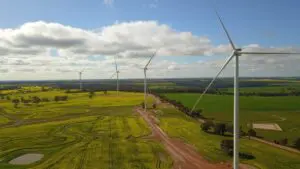Everywhere in the world renewables are built, they keep disappointing. Not in the general sense, but in a very specific sense: conservative, climate skeptics and right-wing fossil fuel think tanks promise their presence will bring an apocalypse of blackouts, and these machines simply fail to deliver.
“Analysis of statistics and trends in power outages in the UK suggests that concerns over security of supply linked to power station closures and increasing use of renewable energy are largely unfounded’, wrote the Energy and climate Intelligence Unit, in 2015.
It’s the same in Germany. And of course, it’s the same in Australia, where the 2016 South Australia blackout kicked off a cultural and political campaign to blame renewables, which in turn became the heart of the country’ climate policy for three full years.
Now it’s the same in California, where a record heat wave – the Mojave Desert may have set a new global heat record of 54.4°C – has led to load-shedding on a significant scale, as the grid operator concedes is was poorly prepared, and conservative media leaped in to attack wind and solar.
https://twitter.com/KetanJ0/status/1223351539013771265
But let’s set the scene the first. I go into some detail in my upcoming book, Windfall, about the media, social and political efforts to blame the disastrous South Australia blackout on renewables. I describe it as an effort to create ‘Chernobyl, but for renewables’.
It succeeded in delaying climate action as then PM Malcolm Turnbull’s efforts at climate policies were hamstrung by the blackouts narrative, but failed to have any lasting impact. Much of this came from media coverage, which operated completely disconnected from the actual status of Australia’s electricity grid.
https://twitter.com/KetanJ0/status/1223149729581871105
Subsequent to 2016, there has been a flurry of blackouts and brownouts, most of which have been caused by failures in the distribution and transmission network, but of which there is an increasing proportion caused by themal power generation assets sweating, cracking and collapsing under the drumbeat of intensifying heatwaves, bushfires and extreme weather events, caused by the very problem they contribute to: climate change.
Some of the tales of these blackouts involve incredible malfeasance. Plant operators simply fail to provide supply at critical times, despite being contracted to do so. Pelican Point – the biggest fossil gas generator in South Australia – is going up against the Australian Energy Regulator for exactly this – a major contributor to widespread blackouts in February 2019, that were blamed on renewables. Meanwhile, South Australia, easily global ground zero for efforts to create deadly disaster from renewable growth, is doing well.
Today I learned that South Australia's electricity grid was isolated for 18 days in January, and ran on 46% solar and wind for that time, using curtailment and ancillary services and batteries and other balancing tricks.https://t.co/UZ3gFk7x46
— Jenny Chase (@solar_chase) August 11, 2020
The Californian experience
If, somehow, you’ve missed it, an incredible heatwave is currently gripping California. Records are toppling, homes and apartments are smouldering, and as is so often in the case in extreme heatwave events, incredible pressure is being placed on the state’s electricity grid.
At the time of writing, a shortfall in the supply of elecitricity (rather than failures in the distribution or transmission network) have resulted in several instances of ‘rolling blackouts’, in which demand is intentionally disconnected to ensure the match between the generation of electricity and the consumption of it by customers. The grid operator – California Independent System Operator (CAISO) – told Bloomberg News these were inevitable, even after they called on reserves.
“We did call on all of our reserves…there was record breaking heat. At 7:30 p.m, the sun was going down and the demand was holding. There is nothing nefarious going on here. We are just trying to run the grid. The peak demand was steady in late hours and we had thousands of megawatts of solar reducing their output as the sun set”, Anne Gonzales from CAISO told Bloomberg.
Breaking: California orders rolling blackouts amid first Stage 3 power emergency since 2001 https://t.co/M9ZQUW0t99
— Los Angeles Times (@latimes) August 15, 2020
Only last year, we saw rolling blackouts across California due to the state’s biggest utility – PG&E – having to reduce the probability of power lines sparking wildfires. That was, of course, blamed on renewable energy. And these are being blamed on renewables too – again, by the usual suspects.
These each follow the pattern of blackout-renewable pairing tactics that dominated Australia. The outages are mentioned, the rise in renewable output in that region is mentioned, and both are simply held aloft while the author nods extremely vigorously. That’s plenty for hungry, anti-climate-action audiences to draw the linkage and presume that the blackouts were caused by the presence of renewable energy. And indeed, California has seen an incredible, world-leading rise in solar power output, as shown by the US EIA’s data:
 It is, interestingly, not that far off South Australia’s solar power data (sourced from OpenNEM), in terms of percentage contribution. It is all very reminiscent of South Australia’s blackout, in which the eminently resolvable challenges of grid integration of renewables are framed as disastrous and unavoidable.
It is, interestingly, not that far off South Australia’s solar power data (sourced from OpenNEM), in terms of percentage contribution. It is all very reminiscent of South Australia’s blackout, in which the eminently resolvable challenges of grid integration of renewables are framed as disastrous and unavoidable.
Like the September 2016 blackouts, the truth is complex. Renewable energy invariably becomes a big chunk of the stack of fuel types on the grid, meaning no matter what type of blackout happens, all types of fuel will be involved somehow. In this case, two gas-fired generators were offline, and demand rose in the evening, well after solar’s peak.
It is becoming clear that this is a story of mismanagement, rather than any problem inherent to renewables. CAISO’s president, Steve Berberich, blames a lack of effort to integrate solar, having warned years ago that significantly more solar power alongside storage technologies were both required to meet demand on hot days, instead of relying on neighbouring states.
yep, Berberich said the ISO "operates the system it is given" and said grid managers have warned the state for years that demand could outstrip supply.
he also indicated that rolling blackouts for millions of people are likely today and tomorrow. https://t.co/h0ccpsVC5X
— J.D. Morris (@thejdmorris) August 17, 2020
According to the New York Times, plenty of energy experts are scratching their heads. Demand was not at record levels, and the variations in solar output were, obviously, very predictable – meaning the grid operator ought to have pre-empted and planned for that, as is regularly the case in Australia.
“The energy experts noted that the peak electricity use over the weekend fell below peaks in other years, when utilities were able to handle the demand. They also said the operating reserves of power available to the utilities were higher than the 3 percent level where California ISO has traditionally ordered a reduction in electricity use”, wrote the NYT. If demand wasn’t unusual, and the reserves of power weren’t unusual, what happened?
It’s still not clear, and it probably won’t be for weeks, or months. What is fascinating to see is how the efforts in this instance to blame renewables have been mostly limited to climate delay / denier blogs like ‘Watts up with That’ and Forbes, along with one piece in News Corp’s US-based Wall Street Journal.
It isn’t a widespread narrative – at least, not yet- which I think is a testament to how diverse the US media environment is compared to Australia’s Murdoch-dominated environment. Hopefully, this campaign to turn blackouts into anti-climate-action fodder won’t succeed.














